SOUTH OF ETHIOPIAN BORDER, CENTRAL NORTHERN KENYA
All Fotos Copyright Jonathan Alpeyrie / Getty Images
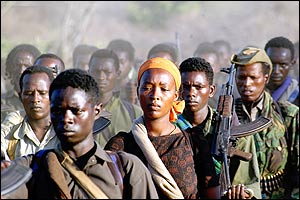
FEBRUARY 3: OLF rebels are regrouping in Northern Kenya to safety, February 3rd, 2006, in Kenya. The OLF is orgaznied militarely as a coventional army, with its platoon, batallion, regiments...
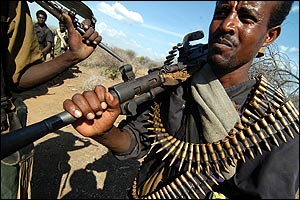
FEBRUARY 3: An OLF soldier carrying a light machine gun is resting after a forced march of over 400 kilometers long, February 3rd, 2006, in Kenya. OLF fighting in Southern Ehtiopia often regroup and retreat into Kenya where the Ehtiopian are more hesitant to look for them.
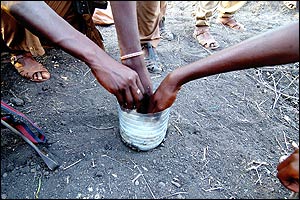
FEBRUARY 4: Three OLF members are eating rice out of a plastic bottle, February 4th, 2006, in Kenya. The lack of food does not allow OLF soldier to eat more than once a day, and often have to share portions, with up to three people.

FEBRUARY 7: OLF troops are marching to their camp after a 400 kilometer walk through the Ehtiopian desert, February 7th, 2006, in Kenya. Discipline is better maintained in the OLF troops than the Ehtiopian militias fighting them. Indeed the militias have a very low morale and try not to fight the OLF when they can.
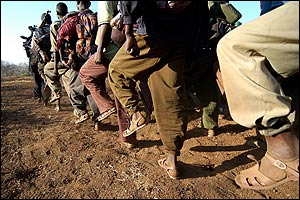
FEBRUARY 7: OLF troopers are practicing quick pace marching soons after entering their newly made camp on the Ehtiopian border, February 7th, 2006, in Kenya. These camps are secret and well hidden in the bushes away from any villages and poeple.
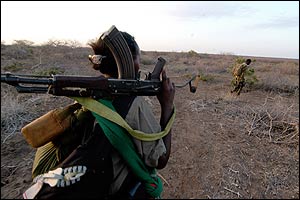
FEBRUARY 7: A small OLF unit is trying to distance Ethiopian troops close by, February 7th, 2006, in Kenya. In times of drought, the OLF tries to evade any confrontation with the militias in order to conserve water.
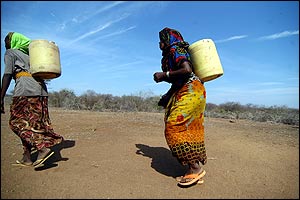
FEBRUARY 9: Oromo women are carrying water for the OLF through the Kenyan desert, February 9th, 2006, in Kenya. The entre Oromo population in Kenya helps the rebellion by giving them monay, foods and water to sustain themselves in harsh times.
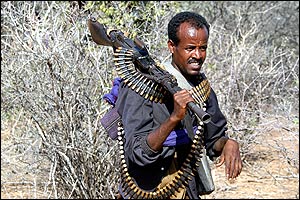
FEBRUARY 10: An OLF soldiers carrying a Russian light machine gun is entring the new camp , February 10th, 2006, in Kenya. The OLF usually disperses its units by small groups of 10 or 15 men each before regrouping in a specific safe location. This is meant to evade Kenyan and Ethiopian troops in the area.
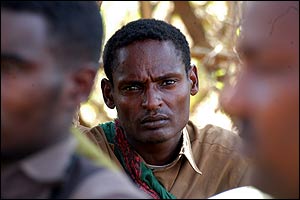
FEBRUARY 12: An OLF soldier is listening to the unit's political cadre, February 12th, 2006, in Kenya. This form of propaganda is meant also to give a purpose for the rebellion.
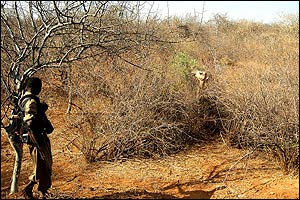
FEBRUARY 15: An OLF guard is watching over a newly captured camel, February 15th, 2006, in Kenya. This camel is living its last moment as it will be killed to feed at least 50 men for three of four days.
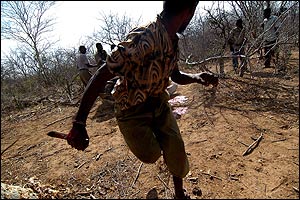
FEBRUARY 15: An OLF soldier has just cut the throat is running away from the animal still quite dangerous, February 15th, 2006, in Kenya. The throat is cut in roder to let all the blood flow out, and therefore weaken the animal, and finishing him off.
|
OLF rebellion
Article by Jonathan Alpeyrie
February 2006
“You have to fight with courage, if you are surrounded by the enemy, always save one bullet for yourself” says the 40 years old Abdata Basire, commander in chief of the Southern front. With this sentence as a rule to all OLF fighters, struggling to protect and give a voice to the Oromo people, their dedication and willingness to die for the struggle is unlimited. It is a reminder of the desperate situation the Oromo people has found themselves into. The Ethiopian government, controlled by the Tigrean ethnic minority has survived the past 15 years trying putting down any signs of resistance to its rule, arresting any protestors, killing and torturing at will. However, it seems that time could be running out for the minority led by Mr. Meles and his generals. Their brutal put down has done nothing but feed the flame of revolt in the Oromo’s harts and their allies. If a democratic election was to take place, it is clear that the Oromo majority would win and therefore change the entire political landscape of the country. This is exactly what Addis does not want, any democratic movement would brush them aside promptly giving way to a new order.
Addis Ababa is now fighting on a few fronts, against 9 major rebel groups, from all parts of the country and of course the powerful Eritrean army on its eastern border. The situation has become critical, its 240 thousand men army (TPLF) does not have the resources to be fighting everywhere at the same time, so it relies on poorly equipped, low morale militias numbering more or less the same number protecting the frontiers. On the Kenyan border, the government has poured in thousands of these poor quality militia units, to try to contain the OLF’s constant military pressure in the region. Their lack of fighting ability is not only explained by forced conscription and low pay, but also because most of the militias fighting in the region are also Oromos. It is said by the OLF that militias sometime refuse to give battle, and won’t shoot directly at OLF troops to make sure not to hurt any of their own kin. This lack of combativeness and regular desertions, has forced Addis to move in regular troops to combat the OLF and smaller rebel groups like the EUPF (Ethiopia United Patriotic Front). But again TPLF has kept a low morale seriously impeding military operation in the region. The rebels have been capturing deserters, who when interrogated, usually just want to go home, some even join the OLF as fighters.
On the ground the OLF has been much more efficient force than TPLF. They have been fighting a long-term war with almost no outside help, and little logistic, while it has managed to control large parts of the countryside in Southern, South East and Western Ethiopia. During the rainy season, the OLF attacks repeatedly governmental positions, forcing the army to defend major urban center and strategic road junctions. The porous border between Ethiopia and Kenya has become a safe heaven for OLF troops retiring after month of continuous war or to avoid military pressure from Addis, allowing them to refit, and regroup. This constant illegal border crossing by OLF and Ethiopian militias has raised security issues in Nairobi, who has failed to tame its Northern border with adequate military resources. In fact the complete lack of Kenyan authority in the area, except for the main and only road leading to Moyale on the border, has allowed both OLF and Ethiopian militias to fight it out in this barren and unforgiving land.
The OLF and its allies have successfully built an arsenal, from small arms to AK assault rifle, light machine guns, and some RPGs. Each weapon carried by OLF soldiers, are taken from dead Ethiopian soldiers, or captured during night raids. In order to compensate for this lack of weaponry and money, the OLF has put much empathies on propaganda work on its soldiers as well as a harsh discipline maintained at all times. With no alcohol or drugs allowed within the units, and an estimated 5 to 10% trained female fighter within the army, the Oromo soldier is driven only by his will to fight for his people and their right for self-determination. Very mobile and self reliante, the OLF freedom fighter can go without water for two days, moving quickly in the Ethiopian desert. The Ethiopian army has had to adopt specific tactical moves to counter this mobility by attacking OLF units with a much larger force and try to encircle them. These tactics have been partially successful in forcing OLF to usually retire from the field to fight another day as ammo is often in short supply, and capture is not an option. However, TPLF has proportionally suffered heavier casualties than its counterpart, which looses between 20 to 30 men killed each month during the rainy season.
The 32-year-old struggle has gain much ground since its beginnings in the early 1970’s: from a mere 10 rebels, it has now grown to perhaps as much as a few thousand freedom fighters, fighting in four major fronts; Southern, Eastern, South Eastern, and Western fronts; and one new front in Walo (Northern Ethiopia), which has just been activated a few weeks ago. The OLF has effectively put pressure on Addis from all sides, forcing the Ethiopian forces to weaken the Eritrean front and its fundamental agricultural lands around Badme. Without them, the government would not be able to feed and sustain its power base in central Ethiopia. Furthermore, the OLF, now the most important rebel group in the entire country, has worked feverishly to gather further forces under its banner. Major rebel groups such as the Muslim Sudanese, the ONLF (Ogaden National Liberation Front) fighting in Eastern Ethiopia, the EPPLF (Ethiopian People Patriotic Liberation Front), fighting in Northern Ethiopia, or the ALF (Affar Liberation Front) fighting in Southern Ethiopia, and groups like the BPM or GLF fighting in Western Ethiopia, have joined the fight. Each has established links with the OLF to help in this common struggle, to force Addis to negotiate or else be supplanted by force.
The three-decade long struggle, is only a reflection to a much longer fight between the Abyssinians placed in power by the British rule in the last decade of the XIXth century, which has been followed by systematic reduction of Oromo power in the social and political arenas. The right of self determination has been since the beginning of the struggle the central piece for their right to rebel against the Tigreans and their tough rule. The other rebel groups in the regions where quick to follow suit, by following the OLF’s lead in self-determination thinking. On paper the OLF and its allies want to negotiate with Addis to find a compromise and share power while organizing free and fair elections, something that Addis has so far rejected. The international community, and specifically the United States and Europe, have been less than happy in seeing the OLF gaining such ground politically and militarily, in fear that these rebels would trade a dictatorship for another. The US, has favored Meles’s government for one simple reason, found in the struggle against terrorism. Meles has promised the United States to fight terrorism wherever he would find it, in return for substantial cash subsidies, mostly used to purchase weapons and ammo, which in turn is used against the OLF, its allies, and people.
Are the fundamentalists present and active in Ethiopia? We know for a fact that they have been in Kenya and Somalia, hitting American interests in the region. However in Ethiopia, no evidence has been found that the fundamentalists have been active against the West. For the OLF, Meles is lying using American and European money to keep oiling his war machine.
So can the OLF be trusted? If they do gain power, will they allow a free and democratic system to take place and allow each minority, including the Tigreans, to be part of the democratic process? In Asmara, the OLF National Congress, a political body that dictates the ideological and political guidelines in which to follow says it will put in place a full democratic State once the war is won. The OLF’s internal political organization does tend to believe that if victory is achieved, Ethiopia would be ruled under the banners of federalism. Each ethnic groups would have a seat in the new government, dictating their own internal affairs. This sounds a little utopic, however, if the OLF decides to end the war as soon as a compromise is possible with Mr. Meles’s and the army to resume talks, then an end to the conflict is foreseeable.
Jonathan Alpeyrie February 2006
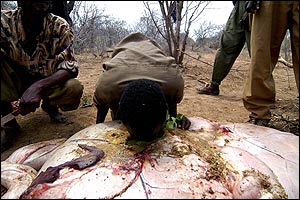
FEBRUARY 15: An OLF fighter is drinking from the camel water reserves, which containes over 100 liters of water, February 15th, 2006, in Kenya. In time of desperate times, the camel's water can be drunk and help sustain a few dozen men for a few days in the desert |
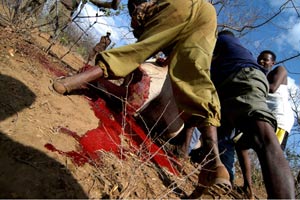
FEBRUARY 15: The butchers are finishing off the camel by cutting more of his throat, February 15th, 2006, in Kenya. The animal is help sustained a full platoon of OLF fighters for a few days at least. |
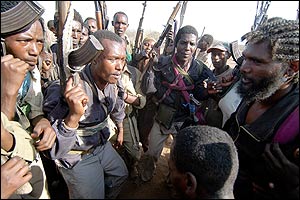
FEBRUARY 16: OLF soldiers are encouraging eachother before going on operation in ehtiopia, February 16th, 2006, in Kenya. This form of fanatism allows each soldiers to face death with courage, and without fear. |
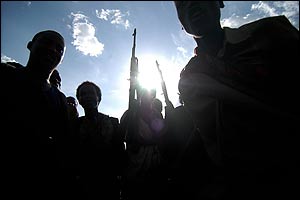
FEBRUARY 16: A group of OLF fighter are chanting and dancing before departing on operation, February 16th, 2006, in Kenya. It is common practice to regroup in such fashion, in order to keep high morale |
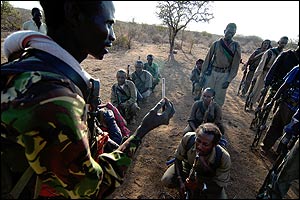
FEBRUARY 16: The unit commander is giving his last orders before the departure of his patrol into Ehtiopian territory, February 16th, 2006, in Kenya. He gives advice on the local topography and the potential dangers in beeing ambushed. |
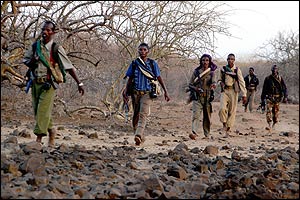
FEBRUARY 16: An OLF patrol is advancing towards the Ehtiopian border to clean it up of potential militias, February 16th, 2006, in Kenya. The OLF is highly mobile and very difficult to track. In one day they can walk up to 80 kilometers without drinking a drop if water. |
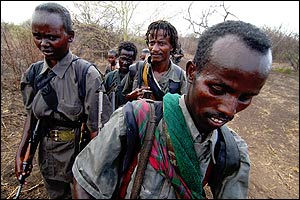
FEBRUARY 18: An OLF patrol is progressing with difficulty into Ehtiopian territory during a heavy rain fall, February 18th, 2006, in Ethiopia. The OLF never moves into enemy territory with more than 15 to 20 men units, in order to evade the militias. |
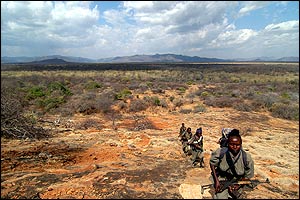
FEBRUARY 18: An OLF patrol is climbing a stratigic elevated position overlooking the Ehtiopian plain from the South, February 18th, 2006, in Ethiopia. This kinds of patrols are meant to make sure no Ehtiopian militias are in ambush. . |
|

